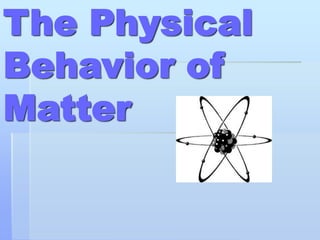
1. MatterandEnergy.ppt
- 2. What is Matter? Anything that takes up space & has mass Substances – variety of matter that has the same composition and properties throughout. Two types are elements (Na) and compounds (NaCl). Mixtures – two or more substances mixed together (not united). Two types are homogeneous (salt water) and heterogeneous (sand and sugar).
- 3. Substances Elements Cannot be decomposed (broken down) Ex: hydrogen (H2), Oxygen (O2) and nitrogen (N2) Compounds Can be decomposed by a chemical change Chemically united Definite proportions Different properties Ex: H2O, NaCl, CO2 A Binary Compound is a compound that only has two elements (NaCl)
- 4. Differences between Mixtures Homogeneous Solutions that are considered one thing. Example: White vinegar Heterogeneous Uneven mixture of two different things. Example: milk
- 5. Ways To Separate Mixtures (1) Distillation- a mixture of liquids can be separated by their boiling points. Examples: distillation of salt water. distillation of petroleum liquids.
- 6. Ways to Separate Mixtures (2) • Filtration- separates the solid and liquid parts of a mixture. • Example: coffee filter which separates the coffee grounds from the brewed coffee.
- 7. Ways of Separating Mixtures (3) Chromatography- way of separating different molecules in a mixture. Example: separating components of chlorophyll.
- 8. Ways of Separating Mixtures (4) Centrifuge- a spinning machine that pushes the most dense particles to the bottom of the tube. Example: separate isotopes such as separating uranium hexafluoride, and uranium-235.
- 9. Ways to Separate Mixtures (5)
- 10. Properties Physical Properties Can be found without changing the substance to something else. Ex. Color, hardness, phase, solubility, odder, density, mass, volume Chemical Properties Are found by making a substance react, and form a new substance. Ex. Burning, reaction w/ water or acid, changing to a new substance.
- 11. Energy The ability to do work. Exothermic- energy given off in a chemical reaction. Endothermic- energy absorbed in a chemical reaction. You measure energy in joules (J).
- 12. Table T Heat q= mCΔT q=heat m= mass q= mHf C= specific heat capacity(table B) ΔT= change in temperature q= mHv Hf= heat of fusion Hv= heat of vaporization
- 13. Sample Problem: How much heat energy in joules if absorbed by 100g of water when it is heated from 20ºC to 30ºC? q= m· C · ΔT q= 100g x 4.18 Joules/gºC x (30 – 20) ºC q= 100g x 4.18 J/gºC x 10ºC q= 4,180 joules
- 14. Heating Curves Heat of Fusion- is the amount of heat needed to change a solid into a liquid at a constant temperature. Heat of Vaporization- is the amount of heat needed to change a liquid into a gas at a constant temperature. Heat of Fusion 334 J/g Heat of Vaporization 2260 J/g Specific heat capacity of H2O(l) 4.18 J/gºC Table B Physical Constants for Water
- 15. Temperature The measure of the average kinetic energy of the molecules. The higher the temperature the more kinetic energy it has. Heat flows from a higher temperature to a lower temperature until they are the same temperature. Measured with a thermometer.
- 16. Temperature continued Boiling Point- when the vapor pressure equals the atmospheric pressure. Freezing Point- the temperature at which a liquid solidifies under a specified pressure. Absolute Zero= -273oC or 0K Kelvin- K= Kelvin ºC = degrees Celsius K = oC + 273
- 17. Changes Physical Change -change in appearance, but no new substance is produced Ex- tearing a piece of paper, heating ice Chemical Change - Produces a new substance with different properties Ex- burning magnesium
- 18. Solids Definite shape, definite volume, and crystalline structure, geometric pattern. Closely packed particles that vibrate but don’t change position. Melting point- temperature when a solid changes into a liquid. Sublimation- the change from a solid directly to a gas. Ex. Dry ice (CO2) & Iodine
- 19. Liquids Definite volume, takes shape of its container. Particles are close together and move :water. Evaporation- when liquid changes into a gas. Ex: water vapor. Vapor Pressure- the pressure that the vapor exerts on the sides of the container.
- 21. Gases No definite volume or shape. Particles are far apart, and can expand anywhere. * When there is a phase change from solid to liquid to gas entropy increases
- 22. Gas Laws Boyle’s Law As pressure increases, volume decreases at constant temperature
- 23. Gas Laws Charles’ Law As volume increases, temperature increases at constant pressure
- 24. What is STP? Standard Temperature and Pressure When you have a combined gas law at STP, use 273 K as your temperature and 101.3 kPa as the pressure.
- 25. Kinetic Molecular Theory (Ideal Gas Law) A model that tells how gasses should behave • Ideal gas- perfect gas that agrees with John Daltons 5 assumptions • Tiny particles • Elastic collisions • Gases are in constant motion • No force of attraction • Temperature is related to speed
- 26. Ideal Gas • Particles have no volume. • No attractive forces • Examples: H2, He Real Gas • Particles have volume • Attractive • Examples: Cl2, H2O(g)
- 27. How do the Gas Laws relate to the Kinetic Molecular Theory? Boyle’s Law • Boyle’s law states that pressure and volume are inversely proportional. • If you have a million molecules in a container and you decrease that container the molecules will hit twice as often, therefore twice the pressure. Charles’ Law • Charles’ Law states that as temperature increases, volume increases. • If you heat the air in a balloon, there will be more pressure on the sides. This makes the balloon bigger in volume.
- 28. Combined Gas Law P1 x V1 = P2 x V2 T1 T2
- 29. THE END
